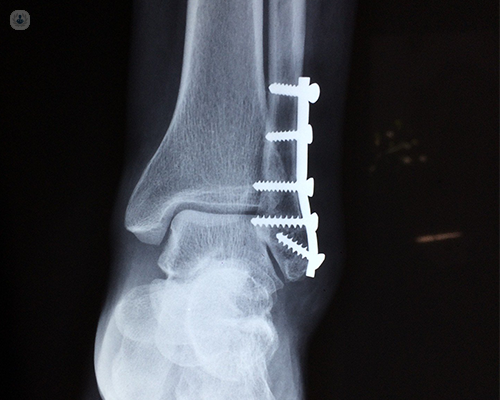Broken (fractured) ankles: FAQs answered by a specialist
Escrito por:Mr Rohit Madhav is an orthopaedic and trauma surgeon and an expert in all there is to know about ankle fractures. In this article, he answers the most common questions regarding ankle fractures. He also offers his warning against returning to regular activity too soon and if you can expect full functionality to return.

How does an ankle break?
Ankle injuries are quite common, particularly in people who take part in physical sports and activities. In the UK alone, there are around 45,000 moderate to severe ankle sprains per annum.
Your ankle contains three bones: the tibia, the fibula and the talus. When one or more of these is cracked, chipped or snapped, it is referred to as a break or fracture and this happens due to:
- trauma from the force of hard impacts
- long-term damage to bones, soft tissues and ligaments
Ankle fractures often occur from sports that involve jumping and quick movements or from accidents such as falling down the stairs. These cause the bone to be twisted or rolled to an abnormal point that the bone(s) can no longer handle.
How is an ankle tested for a broken bone?
If you’re unsure that your ankle is broken, you’ll be checked with a physical examination for the following:
- if swelling occurred immediately after the injury’
- if the range of mobility is heavily restricted
- if blood has gathered around the joint (hemarthrosis)
- if there is a visible irregularity in the shape of the bones (perhaps the foot is not in the right position or the bone may be showing)
Diagnostic tests can get a closer look at the exact location. This will allow your specialist to clarify the type of ankle fracture you have. An X-ray is the standard first test, particularly when the ankle feels painful when pressed and the patient can’t put their weight on their foot. In some cases, an x-ray isn’t necessary. The Ottawa ankle rules are guidelines that specialists can follow to determine if an x-ray should be conducted.
If an x-ray does not gather enough information, an MRI scan may be conducted to get a more thorough look at the ligaments. If a fracture has already been identified, a CT scan might be used for an even more thorough look.
What medical treatment is there for a broken ankle?
After injuring your ankle to the point that it may be broken or is clearly broken, the best actions you can take until you get to a doctor are resting an ice pack on it and elevating the foot. Stable fractures can often be managed non-surgically. The unstable ones mostly require surgery.
Non-surgical methods
The ankle is realigned and a plaster cast or a splint used to hold the joint for around 2-3 weeks. If the break is minor, a soft compression bandage may be all that’s necessary if not, the next stage is a cast or splint.
Physiotherapy is beneficial for all patients regardless of the type of treatment they have previously received. Particularly in cases of severe ligament sprains and fractures, it helps turn a good recovery into a complete one. Furthermore, it reduces the risk of ongoing problems.
Surgical treatment
If the fracture is more complex, surgical treatment may be necessary. This could be in the form of specially designed plates that are put into the bone and whether these will be removed or not after recovery depends on the patient’s lifestyle. The plates will be removed if they interfere with activity and/or cause pain. Some people have a risky lifestyle and are more likely to have a physical injury and these people would be more likely to have it removed.
I broke my ankle - what can I do from home to make it heal faster?
The first thing to do after surgery and throughout recovery is to reduce swelling by consistently wearing a compression bandage, elevating the foot and icing it. Reduce your activity to put as little weight as possible on the ankle for at least two to three weeks.
Nutritionally, make sure that you’re eating a diet with plenty vitamin C, vitamin D and omega oils. Also, supplements can be used to support this diet. If you’re prone to anaemia, you can take iron supplements to counteract the chance of it occurring. Over-the-counter anti-bruise medication can be taken too.
To further support the ankle’s healing process, stay hydrated and don’t smoke.
What if I don’t follow medical advice and go back to activity early?
For bone fractures with a ligament injury, going back to activity too soon can cause the ligament to be slightly reinjured again and again. This can lead to an accumulation of damage that requires surgery to deal with.
For bone fractures without a ligament injury, going back to activity too soon can cause the ankle to heal in a bad position or to the ankle not healing at all. It’s also possible to cause premature arthritis by going back to activity too soon. Either of these repercussions can require future surgery to manage.
Do younger people heal faster?
Generally, all adults heal at the same pace. Everyone over the age of 18 or 19 will heal in a timely way but issues that tend to appear in older people such as diabetes, nerves that aren’t working for other medical reasons, poor circulation), can make the bone heal more slowly than average.
Will my ankle ever be exactly the same as before the break?
If it’s a low-to-medium grade ligament injury or a stable bone fracture, then it’s highly likely that the ankle will be similar to before. With more severe ligaments and unstable fractures, there is always some difference in flexibility and appearance. In terms of function, the majority of people will return to their pre-injury condition and continue with their sports and activities.
Dr Rohit Madhav is an orthopaedic surgeon in London who diagnoses and treats a wide range of orthopaedic conditions. Visit his profile to learn how he can help you.


